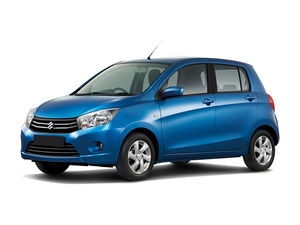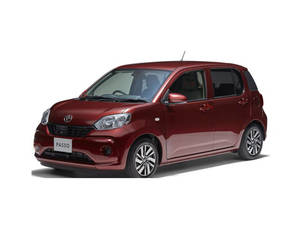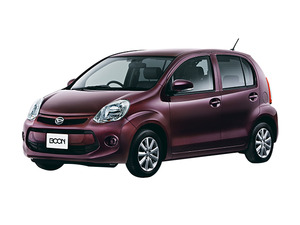The Daihatsu Boon is a compact hatchback that was introduced in 2004 and has made a mark in both the Japanese and global automotive markets.
Developed in collaboration with Toyota (marketed as the Toyota Passo), the Boon is known for its practicality, affordability, and compact, urban-friendly size, which makes it highly suitable for driving in Pakistani cities.
The latest generation of the Daihatsu Boon was introduced in 2016, and its production ended in 2023.
The Boon is primarily offered in two main variants: the regular Boon Cliq and the more stylish and sportier Boon Style. Both variants are equipped with a 1.0L three-cylinder engine and come in multiple trims with slight differences in feature availability.
Daihatsu Boon Specifications
The Daihatsu Boon is powered by a 1.0L 1KR-FE three-cylinder petrol engine, delivering up to 68 horsepower and around 92 Nm of torque. This engine is mated to a CVT (Continuously Variable Transmission), ensuring smooth acceleration and optimal fuel efficiency.
In terms of performance, the Boon takes approximately 13- 14 seconds to accelerate from 0 to 100 km/h, which is typical for its class.
Variants like the Boon Style include slightly sportier design elements but maintain the exact engine specifications.
Fuel consumption ranges between 19 km/l and 21 km/l, depending on driving habits and road conditions, making it a highly fuel-efficient choice for Pakistani buyers.
Daihatsu Boon Exterior
Externally, the Boon measures around 3,650 mm in length, 1,665 mm in width, and 1,525 mm in height, making it ideal for congested city roads. Its tight turning radius aids maneuverability in tight parking spaces.
The Boon is available in a range of colors, including white, silver, pink, and dark blue. Alloy wheels are offered on higher trims. The design remains compact yet modern, with sleek lines and a slightly rounded silhouette that appeals to young and mature audiences.
Daihatsu Boon Interior
The interior of the Boon is surprisingly spacious for a hatchback in this category.It can comfortably seat up to five passengers with good legroom and headroom, especially in the rear. The cabin materials are basic but durable, with cloth upholstery and soft-touch elements in upper trims. The dashboard layout is functional with a centrally mounted infotainment screen that supports navigation and audio playback. It includes keyless entry, push-start ignition, and automatic climate control.
Infotainment
The Daihatsu Boon's infotainment system is functional and user-friendly, tailored for drivers who prefer practicality over luxury.
Depending on the variant and model year, imported units may come equipped with a touchscreen display and four speakers that support radio, Bluetooth, and USB connectivity. This allows users to connect their smartphones for music playback and hands-free calls.
Some models also include steering-mounted audio controls for added convenience. The digital-analog instrument cluster is clear and easy to read. It typically features a central speedometer flanked by digital displays that show fuel level, average fuel consumption, a trip meter, and gear position.
Higher trims may also include eco-driving indicators and alerts that help promote fuel-efficient driving habits. While the system doesn't offer advanced features like Apple CarPlay or Android Auto in most trims, it adequately meets the needs of daily commuters in Pakistan who prefer straightforward controls and reliable functionality.
Daihatsu Boon Safety Features
Safety is where the Daihatsu Boon shines for a car in its segment. Depending on the model year, it comes equipped with Smart Assist II or III, which includes automatic emergency braking, lane departure warning, collision warning, and pedestrian detection systems.
Dual front airbags, ABS with Electronic Brake Distribution (EBD), and traction control are standard across most trims, making the Boon a well-rounded vehicle for basic safety assurance.
Daihatsu Boon Mileage
Known for its compact body yet surprisingly spacious interior, the Boon offers exceptional fuel economy, averaging around 18-21 km/l, depending on driving conditions and variants. It has a 38 L fuel tank.
Daihatsu Boon price in Pakistan in 2025
According to the latest updates, Boon's price in Pakistan in 2025 ranges between 31.8 - 35.4 lacs, depending on the engine variant, model year, trim level, and optional features included.
Daihatsu Boon Competitors
In the Pakistani market, the Daihatsu Boon competes with several other imported hatchbacks, including the Toyota Passo, Suzuki Swift (a Japanese variant), Nissan Dayz, and Honda N-WGN.
The Toyota Passo is nearly identical, sharing the same platform, engine, and features. However, the Boon Style trim stands out with more distinctive exterior elements.
Compared to the Suzuki Swift, the Boon offers better fuel efficiency but slightly less power and acceleration. The Swift can do 0-100 km/h in under 12 seconds, compared to the Boon's 13-14 seconds.
The Boon offers better ride comfort and more reliable engine performance than the Nissan Dayz and Honda N-WGN.
However, it may lack some of the ultra-modern infotainment and digital cluster features in newer kei cars. The Boon is competitively priced, often more affordable than fully loaded Swift or Passo variants, and is certainly more cost-effective in the long term in terms of fuel economy.
Daihatsu Boon Maintenance Tips
- Regular oil changes every 5,000 km help maintain engine health and efficiency.
- Use high-quality CVT fluid and replace it every 40,000 km to ensure smooth gear shifts.
- Clean the air and AC filters every 10,000 km to maintain cabin comfort and engine performance.
- Periodic checks of Smart Assist sensors and cameras are essential for ensuring the accuracy of safety features.
- Ensure tire pressure is maintained at recommended levels (typically 32 PSI) for optimal mileage and handling.
- Battery health should be inspected every 6 months, especially if your Boon has push-start ignition and idle stop features.
Is Daihatsu Boon Worth Buying?
The Daihatsu Boon is worth considering for anyone looking for a compact, fuel-efficient, and feature-rich hatchback that meets the demands of urban commuting in Pakistan.
Its standout features include excellent fuel economy, a decent safety suite, and a spacious cabin layout, despite its compact exterior dimensions.
It often delivers better fuel efficiency and lower maintenance costs compared to rivals. While it may not offer premium performance or luxury features, it strikes a strong balance between affordability and functionality.
Its imported status means a slightly higher upfront price tag, but lower fuel and maintenance expenses make it economical in the long run.
So, when comparing the Daihatsu Boon to the Suzuki Swift or the Boon to the Toyota Passo, the Boon remains a highly competitive option.
More
















